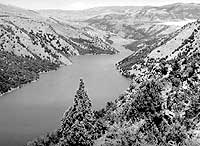|
Page
69
|
Mormon
Settlements and the use of Water
Early Mormon Pioneers,
led by Brigham Young, changed the desolate deserts of the valleys of the intermountain
west into green, productive farmland. The construction of canal systems, which
in the Lake Bonneville basin took advantage of existing shoreline benches on
the edges of valleys to feed water to the former lake bottoms below, allowed
mixed farming in mountain valleys which had formerly supported only sagebrush
and grasses.
|
As Mormon settlers moved into southern Idaho in the 1860s, it was obvious that the land had to be irrigated for farming to be feasible. Irrigation canals were built in Cache and Malad Valleys soon after settlement. Much of the country too high or too rugged to irrigate became grazing land.
In the early 20th century, the determined efforts of the Last Chance Canal Company to bring irrigation water to the Grace area in Gem Valley were opposed by the Utah Power and Light Company, which sought the water for hydroelectric generation. The historic Dietrich Decree of 1919 awarded water rights to the Mormon farmers who had filed on it first. One of the primary tenets of Western water law (first in time is first in right) had been established (mcCarthy, 1987).
Irrigation
of the Snake River System
North of the Mormon
country, there were limited attempts to establish irrigation systems. Rev. Henry
Spaulding at the Lapwai Mission, up the Clearwater River from Lewiston, developed
some irrigation during the 1830s and 40s as he tried to turn the Nez Perce of
the area into farmers. The first Mormon settlement in Idaho, in 1855 at Fort
Limhi along the East Fork of the Salmon River, built an irrigation system.
 |
| Oneida Narrows Reservoir, north of Preston, looking southeast from high above the west shore. The dam is at the narrow constriction in the distance. The rocks here belong to the Late Proterozoic and Cambrian Brigham Group, (august, 1985). |
Through the sagebrush desert of much of southern Idaho, the Snake River flowed full of water along treeless plains, adjacent to vast fields of fertile soil which were unproductive because the nearby waters could not be diverted. The Snake drains a huge area which usually has heavy snows in the winter and from which a number of tributaries flow.
An area several hundred miles long north of the Snake River between Henry's Fork in eastern Idaho to the Malad River (the continuation of the Wood River) at Hagerman Valley contains almost no surface streams that persist as far as the Snake. Extensive lava flows block the pre-existing drainage channels. In these areas are large underground water supplies contained within the Snake River Plain Aquifer.